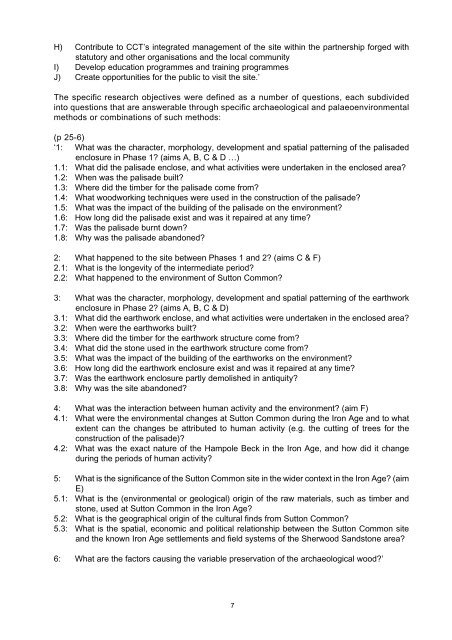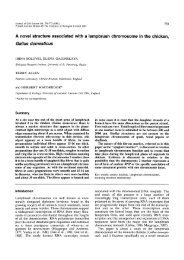Sutton Common Updated project design - University of Exeter
Sutton Common Updated project design - University of Exeter
Sutton Common Updated project design - University of Exeter
You also want an ePaper? Increase the reach of your titles
YUMPU automatically turns print PDFs into web optimized ePapers that Google loves.
H) Contribute to CCT’s integrated management <strong>of</strong> the site within the partnership forged with<br />
statutory and other organisations and the local community<br />
I) Develop education programmes and training programmes<br />
J) Create opportunities for the public to visit the site.’<br />
The specific research objectives were defined as a number <strong>of</strong> questions, each subdivided<br />
into questions that are answerable through specific archaeological and palaeoenvironmental<br />
methods or combinations <strong>of</strong> such methods:<br />
(p 25-6)<br />
‘1: What was the character, morphology, development and spatial patterning <strong>of</strong> the palisaded<br />
enclosure in Phase 1 (aims A, B, C & D …)<br />
1.1: What did the palisade enclose, and what activities were undertaken in the enclosed area<br />
1.2: When was the palisade built<br />
1.3: Where did the timber for the palisade come from<br />
1.4: What woodworking techniques were used in the construction <strong>of</strong> the palisade<br />
1.5: What was the impact <strong>of</strong> the building <strong>of</strong> the palisade on the environment<br />
1.6: How long did the palisade exist and was it repaired at any time<br />
1.7: Was the palisade burnt down<br />
1.8: Why was the palisade abandoned<br />
2: What happened to the site between Phases 1 and 2 (aims C & F)<br />
2.1: What is the longevity <strong>of</strong> the intermediate period<br />
2.2: What happened to the environment <strong>of</strong> <strong>Sutton</strong> <strong>Common</strong><br />
3: What was the character, morphology, development and spatial patterning <strong>of</strong> the earthwork<br />
enclosure in Phase 2 (aims A, B, C & D)<br />
3.1: What did the earthwork enclose, and what activities were undertaken in the enclosed area<br />
3.2: When were the earthworks built<br />
3.3: Where did the timber for the earthwork structure come from<br />
3.4: What did the stone used in the earthwork structure come from<br />
3.5: What was the impact <strong>of</strong> the building <strong>of</strong> the earthworks on the environment<br />
3.6: How long did the earthwork enclosure exist and was it repaired at any time<br />
3.7: Was the earthwork enclosure partly demolished in antiquity<br />
3.8: Why was the site abandoned<br />
4: What was the interaction between human activity and the environment (aim F)<br />
4.1: What were the environmental changes at <strong>Sutton</strong> <strong>Common</strong> during the Iron Age and to what<br />
extent can the changes be attributed to human activity (e.g. the cutting <strong>of</strong> trees for the<br />
construction <strong>of</strong> the palisade)<br />
4.2: What was the exact nature <strong>of</strong> the Hampole Beck in the Iron Age, and how did it change<br />
during the periods <strong>of</strong> human activity<br />
5: What is the significance <strong>of</strong> the <strong>Sutton</strong> <strong>Common</strong> site in the wider context in the Iron Age (aim<br />
E)<br />
5.1: What is the (environmental or geological) origin <strong>of</strong> the raw materials, such as timber and<br />
stone, used at <strong>Sutton</strong> <strong>Common</strong> in the Iron Age<br />
5.2: What is the geographical origin <strong>of</strong> the cultural finds from <strong>Sutton</strong> <strong>Common</strong><br />
5.3: What is the spatial, economic and political relationship between the <strong>Sutton</strong> <strong>Common</strong> site<br />
and the known Iron Age settlements and field systems <strong>of</strong> the Sherwood Sandstone area<br />
6: What are the factors causing the variable preservation <strong>of</strong> the archaeological wood’<br />
7
















